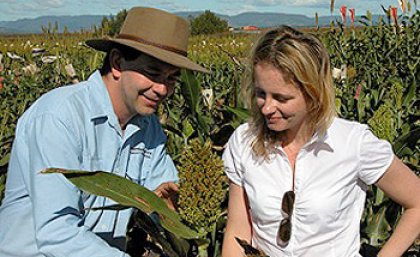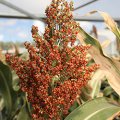
A consortium of Australian and Chinese researchers has discovered that sorghum, Africa’s most widespread crop, contains vastly more genetic variation than previously realised.
In a scientific paper published in Nature Communications this week, researchers from The University of Queensland, the Queensland Department of Agriculture, Fisheries and Forestry (DAFF Qld) and BGI (China), announced they had mapped the entire genome sequence in 44 sorghum lines.
Funded by the Australian Research Council (ARC) and Australian farmers through the Grains Research and Development Corporation (GRDC), the project is part of efforts to improve drought tolerance and nutritional quality in sorghum.
Due to its better adaptation to heat and drought, sorghum is expected to play an increasingly important role in feeding the world’s growing population.
While sorghum is a staple cereal crop for 500 million resource-poor people in Africa and Asia, and an important animal feed and biofuel crop in the developed world, agriculture faces enormous challenges to meet world food demand in the face of climate change, land degradation and increasing water scarcity.
The study’s lead author, DAFF’s Dr Emma Mace, said the sorghum sequence information they had generated would provide the best genomic information to date on this important crop.
“What has been poorly understood, until now,” Dr Mace said, “is the nature of genetic diversity at the genomic sequence level.”
Armed with this data, researchers can now examine variation in specific genes and use this information to breed improved sorghum varieties.
“Our study revealed a dramatic reduction in the diversity of modern varieties compared to the wild ancestors,” Dr Mace said.
“It really highlights the exciting opportunities sorghum plant breeders have to make use of previously untapped variation.”
This resource is not just important for sorghum; cereal crops share most of their genes in common so an understanding of drought mechanisms in one crop can be used to improve drought adaptation in other crops such as wheat and rice.
The results of this study have already had an impact on UQ research, allowing scientists to focus on improving the quality and drought resistance of sorghum.
One of the study’s authors, UQ’s Professor Ian Godwin, leads a research group focused on improving the quality of sorghum for human and animal nutrition.
Data from this study contributed to research published in Nature Communications earlier this year in which the agriculture scientists identified a gene which improves the food value of sorghum.
“Having access to these sequences makes it much easier to understand difficult traits such as grain quality,” Professor Godwin said.
“While an important staple, sorghum’s low digestibility presents a fundamental challenge for its utility as a food source and this research could provide new options for securing food supplies in Africa and Asia.”
Dr David Jordan, from UQ’s Queensland Alliance for Agriculture and Food Innovation (QAAFI), leads Australia’s national sorghum genetic improvement program.
He is using this information to breed improved sorghum varieties for Australia and Africa.
“Five years ago, we would not have believed that we would have access to this sort of detailed understanding of sorghum genes,” Dr Jordan said.
“Already we are using the information in our GRDC funded pre-breeding program and it will play a key part in a new project to identify genes for drought tolerance funded by the Bill & Melinda Gates Foundation.”
Media: Ron Hohenhaus, QAAFI Communications, 3346 0553, 0417425510 or r.hohen@uq.edu.au. Dr David Jordan, Sorghum Plant Breeder and Team Leader, 4660 3622.


.jpg)



